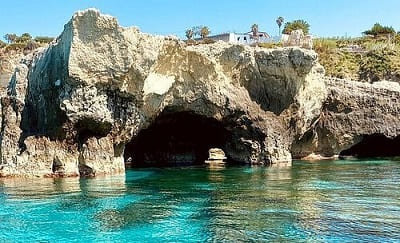Home › A-Z Destinations › Diving in Europe › Cyprus
Scuba Diving around Cyprus
There are numerous reasons why divers and snorkelers should explore this large island. But, the diversity between sandy-bottom reefs and awe-inspiring shipwrecks is the leading attraction.
This section contains a list of Cyprus dive sites with information about the marine life plants and animals that exist in the north-eastern corner of the Mediterranean Sea.
What are the Best Months to Dive at Cyprus
Covering an area of some 9,251 square kilometres means the island of Cyprus is the third largest in the region.
In addition, an intense hot and sunny climate bathes the Mediterranean island from May until October.
Despite being a little cooler at the beaches, air temperatures can reach in excess of 30° Celsius in the hottest months (July and August).
Even though the winters are mild, you can expect to see snow covering the Troodos Mountains by late December.
During the summer months, water temperatures should hover around 27° Celsius in the open sea. Nonetheless, the average sea temperature will be around 16° Celsius during the cool winter months (January to March).
Is Cyprus Good for Scuba Diving?
We often get asked, "can you learn scuba diving without knowing swimming"? The short answer is yes you can via the introductory scuba programs.
This is one of the reasons why learning to scuba dive in Cyprus is very popular with tourists. There is no shortage of shallow, sheltered bays with clean sandy patches for beginners to practice buoyancy skills.
But wait - there's more:
In years gone by, the north-eastern Mediterranean was geographically important for shipping. Hence, experienced divers will find some amazing examples of man made artificial reefs resting on the seabed.
Pro Tip: Having dived on the MS Zenobia Challenger-class RO-RO ferry myself, I can personally confirm this ranks as one of the best wreck dives in Europe.
Marine Life in the Mediterranean Sea
This sea connects to the Atlantic Ocean and yet it only covers 0.7% of the global ocean surface (2,500,000 square kilometres).
Even so, it holds 10% of all known marine species and you can't find 28% of these anywhere else on Earth. Some of the noteworthy residents are dolphins and porpoises, monk seals, eight whale species, and over eighty different species of sharks and rays.
Some of the common marine life sightings that scuba divers and snorkelers should see around Cyprus, include:
- Black scorpionfish (Scorpaena porcus)
 Blenny fish
Blenny fish- Common dolphinfish (mahi-mahi)
- Dusky grouper
- European eel (Anguilla anguilla)
- Goby fishes
- Loggerhead turtle
- Mediterranean cardinalfish (Apogon imberbis)
- Mediterranean rainbow wrasse
- Parrotfish
- Sea bass (Dicentrarchus labrax)
- Weever fish
- Wrasses (Labridae)
Pro Tip: One of the most protected species of all is the Mediterranean monk seal - which is seeing a diminishing degradation of its typical habitat (e.g. secluded beaches and underwater marine caves).
Popular Dive Sites in Cyprus
The most popular dive sites around Cyprus include reef dives, steep wall dives, and lots of sunken shipwrecks, at:
- Ayia Napa and Protaras
- Kyrenia
- Larnaca
- Limassol
- Paphos
Pro Tip: Further development of this section will include the popular Cyprus dive sites found at Ammochostos, St. George Island, and the Karpaz Peninsula in the north.
Related Information and Help Guides
- Scuba Diving in Croatia
- Scuba Diving in Cyprus
- Scuba Diving in Malta
- Scuba Diving in Spain
- Scuba Diving in the United Kingdom
How to Get There
It's common for many visitors to reach the island by ferry boat or as part of a tour. Even so, the majority of independent travelers will fly into one of the major international airports at Larnaca or Paphos.